Killer Bugger
The Killer Bugger is a cross between a Killer Bug and a Woolly Bugger, basically just a Killer Bug with a marabou tail. The Woolly Bugger has proven itself everywhere, and the Killer Bug has proven itself everywhere people have tried it. I'm pretty confident the Killer Bugger will, too.
In the summer of 2014, I held a TenkaraBum Challenge - What can you catch with a Black Killer Bugger? Anglers caught 54 species of fish! This fly works!
I would suggest tying it in a wide range of sizes, at least from size 6 down to a size 20. A large percentage of the species caught were caught with a Black Killer Bugger tied on size 20, 1XL nymph hook with a 2mm gold tungsten bead. I first fished the fly in a size 12, without a bead, and that's what I still use most, but the size 20 bead head is at least as good.
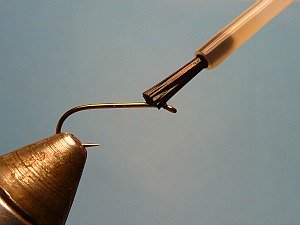
1. Because copper wire tends to slip when wrapped, I start with a touch of super glue on the hook shank. I find a brush applicator works best.
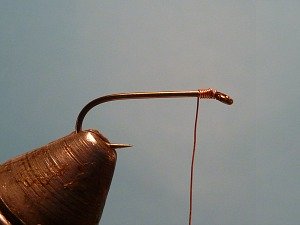
2. For a slightly heavier Killer Bugger, start wrapping the wire just in front of the bend. Wrap to the eye and then make 8 wraps back towards the bend. for a slightly lighter fly, start at the eye, trapping the wire exactly the same way you start thread. I use Ultra Wire, size small, copper for black Killer Buggers and red for white Killer Buggers.
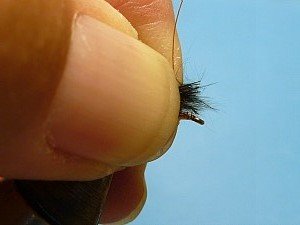
3. Cut a bunch of marabou so that the length of the marabou is about twice the length of the hook shank. Hold the marabou pinched between your thumb and index finger on top of the hook shank directly above where you stopped wrapping the copper wire, with the cut ends of the marabou right at the hook eye. Bring the copper wire up between your thumb and the marabou, and down between your index finger and the marabou, while still pinching the marabou.
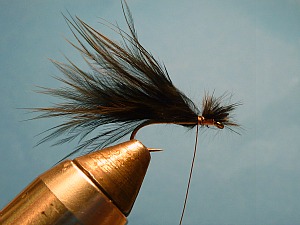
4. Gradually tighten the wire, holding the marabou in place. Make about three wraps of copper wire, after which it should look like the photo above.
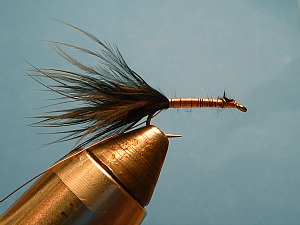
5. Trim the ends of the marabou close, then wrap the copper wire in touching turns to just before the hook bend. Wrap firmly but not firmly enough to break the wire. How do you know? You break the wire a few times. Then you know.
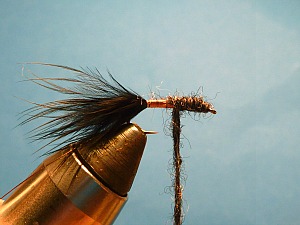
6. Start the yarn the same way you would start thread, just behind the hook eye. After about 6 wraps, cut the tag end. When wrapping the yarn, wrap without much tension on the front half of the fly and with increasing tension on the back half of the fly. The taper is achieved primarily by different tension when wrapping the yarn.
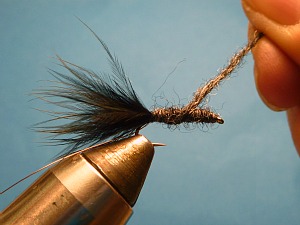
7. After you get to the where you stopped wrapping the wire, take one very wide wrap back to the middle of the hook shank, then start wrapping with touching turns and without much tension to the eye and back toward the bend. As you get to the middle of the hook shank, increase the tension on the yarn. You may have to hold what you have already wrapped, right at the bend, to keep your previous wraps from rotating around the hook shank.
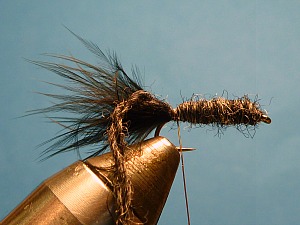
8. When you get to the where you had previously stopped wrapping the wire and the yarn, take one tight wrap of the copper wire around the yarn to hold it in place. Then do a 5 wrap whip finish with the copper wire (touching turns, with each turn in front of the previous one). Pull the wire gently to tighten and then break if off the wire. Cut the extra yarn as close to the wire as you can. I almost never use head cement on the wire whip finish. I always lose the fly before it comes apart. Gently brush the fly with the hook part of some Velcro to pull fibers out away from the body. The loose fibers serve the same purpose as the hackle on a standard Woolly Bugger.
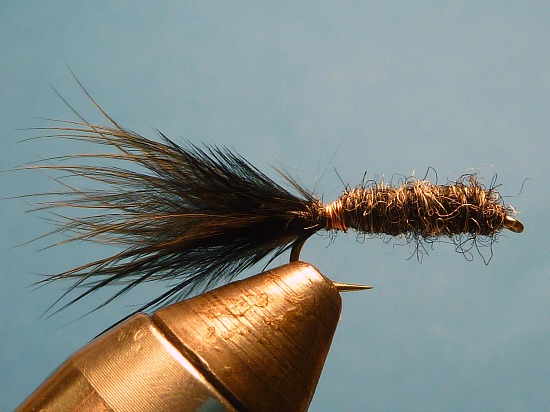
Hook: Daiichi 1560 size 12
Wire: Ultra Wire, small, copper
Tail: Black Woolly Bugger Marabou
Yarn: Jamieson's Shetland Spindrift "Oxford"
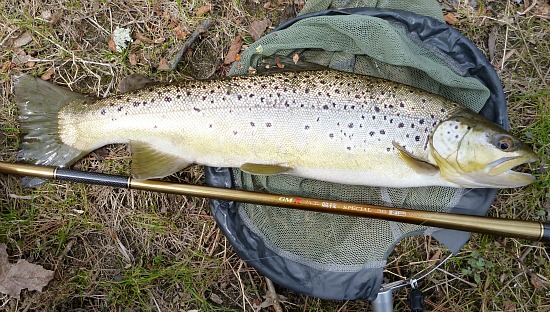 My first trout caught with a black Killer Bugger.
My first trout caught with a black Killer Bugger.Killer Bugger for Micros
A Killer Bugger is an excellent fly to use when fly fishing for micros. It is easy to tie in sizes 20-26, which will catch all but the smallest micros. The tying sequence is the same as with the larger fly shown above, with just a few modifications.
First, I often use a bead head when tying a micro bugger to make sure it breaks the surface tension.
Second, I highly recommend using very thin thread rather than wire. The bead head provides sufficient weight, and wire is too thick for such a small fly.
Third, I highly recommend splitting the yarn so you tie with only one strand. The Jamieson's Shetland Spindrift I use for Killer Buggers is a two ply yarn. Use just one, and do not use extreme tension when tying or you will pull the yarn apart.
Fourth, use only a few marabou feather barbs for the tail. Fish can't count, but the overall impression of a fly with just 3 or 4 barbs for the tail is much, much different than the impression of a fly with a full, bushy tail. For micros, you are tying to imitate a small mayfly nymph, not a hellgrammite or leech.
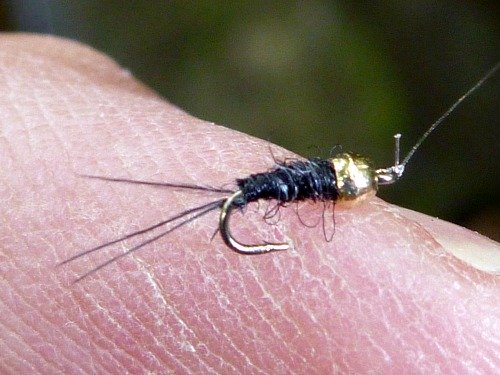 Size 26 bead head black Killer Bugger
Size 26 bead head black Killer BuggerTenkaraBum Home > Tenkara Flies > Killer Bugger
“The bitterness of poor quality remains long after the sweetness of low price is forgotten” - Benjamin Franklin
"Be sure in casting, that your fly fall first into the water, for if the line fall first, it scares or frightens the fish..." -
Col. Robert Venables 1662
As age slows my pace, I will become more like the heron.
We've all had situations where seriously chewed up flies kept catching fish after fish after fish. It is no sin to tie flies that come off the vise looking seriously chewed up.
Warning:
The hooks are sharp.
The coffee's hot.
The fish are slippery when wet.
Beware of the Dogma
Seriously, all the hooks sold on TenkaraBum.com, whether packaged as loose hooks or incorporated into flies, are sharp - or as Daiichi says on their hook packages, Dangerously Sharp. Some have barbs, which make removal from skin, eyes or clothing difficult. Wear eye protection. Wear a broad-brimmed hat. If you fish with or around children, bend down all hook barbs and make sure the children wear eye protection and broad-brimmed hats. Be aware of your back cast so no one gets hooked.
Also, all the rods sold on TenkaraBum.com will conduct electricity. Do not, under any circumstances, fish during a thunder storm. Consider any fishing rod to be a lightning rod! Fishing rods can and do get hit by lightning!
What's in stock?
Kurenai II AR 30F
Kurenai II AR 33F
Kurenai II AR 39F
TenkaraBum 33
TenkaraBum 36
TenkaraBum 40
Nissin Oni Tenkara Line
Coming Soon
Expected January 13
Furaibo TF39
Furaibo TF39TA
Latest Pages
If you enjoy spin fishing or baitcasting please visit my sister site Finesse-Fishing.com.
I purchased several colors of yarn from you and the first fly I tied was the black killer bugger. I did not take any pictures because I was to busy catching large bluegill. This fly is incredible. I almost felt guilty it was so easy. Thanks for a great product. Keep up the good work.
Chris A, Georgia
Had a fabulous day at a local pond yesterday. A buddy and I caught countless fish and mostly on a smallish Black Bugger.
Stephen M, Massachusetts
The rod [Suntech Suikei 39] was best part of a tough two day trip on rain swollen mountain streams. It casts beautifully and handled two 14/16" rainbows in full charge. Had strong heavy currents so not typical trout fishing. Fished traditional kebari with poor results both days but a switch to the Killer Bugger immediately brought the most and biggest fish.
Bill H, Georgia
I had a nice day fishing at a local pond. Caught lots of bluegills and a 15 inch large mouth bass using a black killer bugger size 12. Lots of fun!
Michael M, New Jersey
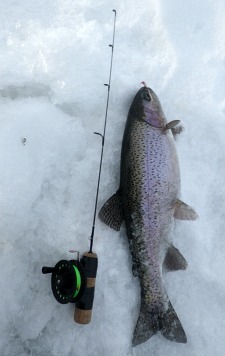
I managed to catch a few nice trout on unbaited black bead head Killer Buggers tied on small jig hooks that I jigged through the ice
Douglas M, Alberta


